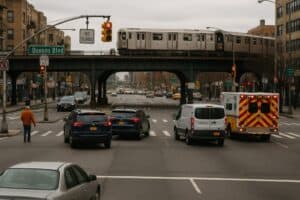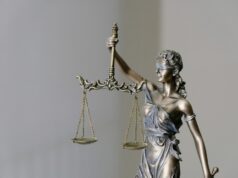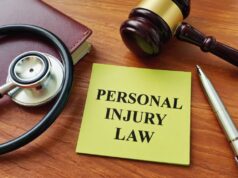Queens is one of the most dynamic and congested boroughs in New York City. With highways feeding in from Long Island, central boulevards carrying tens of thousands of cars daily, and residential streets crowded with both drivers and pedestrians, traffic in Queens has a character all its own. For clients pursuing accident claims, this local knowledge is not just background detail; it directly affects how attorneys establish liability and present evidence. NY personal injury lawyers focused on Queens cases often use traffic flow patterns and accident trends to create strategies that resonate with judges and juries.

Major Arteries That Define Queens’ Traffic
Queens Boulevard: The “Boulevard of Death”
Queens Boulevard has earned its reputation as one of the most dangerous roadways in the city. With wide lanes, heavy traffic, and frequent pedestrian crossings, this corridor has been an accident hotspot. Even with safety redesigns and added crosswalk protections, pedestrian collisions and vehicle crashes remain common. Injury attorneys often cite accident statistics along this boulevard to establish patterns of negligence and to highlight the borough’s unique roadway hazards.
Van Wyck Expressway and Long Island Expressway
Highway congestion also shapes accident trends in Queens. The Van Wyck and Long Island Expressways are well known for heavy traffic. Drivers often face stop-and-go congestion, sudden lane changes, and, when the roads finally open up, dangerous bursts of high-speed driving. It is a combination that regularly causes rear-end accidents, sideswipes, and even multi-car pileups. When handling claims arising from these highways, lawyers often turn to traffic flow data, state trooper reports, and accident reconstruction experts to prove fault in environments where congestion and aggressive driving are the norm.
Residential and Commercial Corridors
Its busy neighborhoods and commercial corridors also shape Queens. In places like Flushing, Jackson Heights, and Jamaica, the streets are packed with pedestrians, delivery trucks often double-park, and cyclists weave through the traffic. With cars, trucks, bikes, and people all sharing the same crowded space, accidents are almost inevitable. Crosswalk incidents, bike crashes, and collisions involving ride-share drivers are especially common. When these accidents happen, attorneys often have to piece the story together using surveillance footage, witness accounts, and even the timing of traffic signals.
Temporal Patterns and Their Legal Impact
Traffic in Queens is highly time-dependent. Morning and evening rush hours create predictable congestion, especially around bridges and tunnels leading into Manhattan. Accidents are prevalent at these peak times due to stop-and-go traffic, distracted drivers, and increased pedestrian crossings.
Seasonal variations also play a role. During winter months, icy conditions on elevated highways like the Grand Central Parkway increase the likelihood of multi-vehicle crashes. In summer, traffic spikes around destinations such as Citi Field, Flushing Meadows–Corona Park, and JFK Airport, creating higher risks of pedestrian accidents and fender benders in parking lots and access roads. For injury attorneys, establishing when an accident occurred is often just as important as showing where it happened.
Local Infrastructure and Accident Liability
Queens’ infrastructure is under constant strain. Construction projects, lane closures, and poorly maintained road surfaces contribute to accident risks. Pothole claims, for example, are common in neighborhoods like Astoria and Elmhurst, where heavy truck traffic accelerates road wear. Attorneys pursuing injury cases often have to identify whether liability rests with the city, the state, or private contractors responsible for maintenance.
Public transportation also shapes accident litigation. With dozens of bus routes and subway stations spilling passengers onto busy streets, collisions involving pedestrians leaving transit hubs are frequent. Establishing negligence in these situations often involves combining MTA schedules, crosswalk timing data, and accident reports to reconstruct events accurately.
Jury Perceptions and Local Experience
One thing that makes Queens cases unique is the perspective of the jurors themselves. Many people who serve on juries here drive these same streets every day. They know what it’s like to sit through long red lights on Queens Boulevard or deal with the chaos of Roosevelt Avenue. Their own experiences with congestion, aggressive drivers, and tricky intersections shape how they see what counts as ‘reasonable behavior’ behind the wheel. For attorneys, it is essential to frame arguments with that local experience in mind, since jurors who live it daily may view a case very differently than someone unfamiliar with Queens traffic.
Looking Ahead: Changing Patterns in Queens
Traffic in Queens is not static. The expansion of bike lanes, pedestrian plazas, and Vision Zero safety initiatives continues to reshape how people move around the borough. While these changes may reduce certain types of accidents, they also introduce new litigation issues, such as collisions between cyclists and pedestrians or disputes over right-of-way in redesigned intersections. Attorneys handling Queens cases must remain alert to these evolving patterns to stay effective advocates for their clients.
Final Thoughts
Queens’ traffic patterns are complex, influenced by a combination of highways, neighborhood streets, transit hubs, and seasonal variations. Each of these factors contributes to the borough’s high accident rates and the unique challenges of litigating cases here. NY personal injury lawyers focused on Queens cases understand how these traffic dynamics shape liability and case strategy, giving their clients a critical edge in the courtroom.




